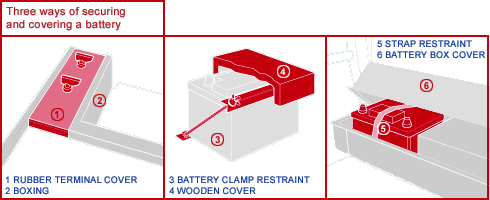The provisions of this section of Part 3 in the 2002 BSS Standards are mandatory for non-private boats where applicable.
To stop batteries from moving around, which could cause damage to their terminals and connections, or cause them to spill corrosive liquids over the boat, they must be securely fixed.
A source of ignition, like batteries, must be kept away from potential fuel sources to reduce the possibility of fire or explosion. So, batteries can be kept in the engine room, but they must never be under or next to a petrol or LPG tank, cylinder, stopcock, pipe or filter. It's a good idea to keep your boat's batteries at least half a metre (around 18ins) away from any petrol or LPG equipment.
If your batteries are kept in confined spaces in compartments it's essential that the build-up of flammable hydrogen gas is prevented. To achieve this, battery compartments must be properly ventilated.
To prevent sparks being created by metal objects or tools touching the top of batteries, which could act as an ignition source and start a fire or explosion, the positive and negative terminals of all batteries must have insulated covers in place. Some batteries don't have individually covered terminals, and traditional batteries have exposed connectors between the cells - in these cases you must cover the whole top surface of the battery. Covering batteries will also reduce the likelihood of electrical sparks caused by touching the terminals with a metallic object. [3.1]

